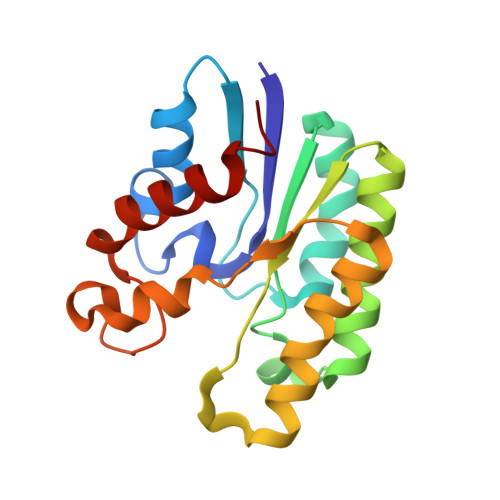Structure-guided reshaping of the acyl binding pocket of 'TesA thioesterase enhances octanoic acid production in E. coli.
Deng, X., Chen, L., Hei, M., Liu, T., Feng, Y., Yang, G.Y.(2020) Metab Eng 61: 24-32
- PubMed: 32339761
- DOI: https://doi.org/10.1016/j.ymben.2020.04.010
- Primary Citation of Related Structures:
6LFB, 6LFC - PubMed Abstract:
Medium-chain fatty acids (C6-C10) have attracted much attention recently for their unique properties compared to their long-chain counterparts, including low melting points and relatively higher carbon conversion yield. Thioesterase enzymes, which can catalyze the hydrolysis of acyl-ACP (acyl carrier protein) to release free fatty acids (FAs), regulate both overall FA yields and acyl chain length distributions in bacterial and yeast fermentation cultures. These enzymes typically prefer longer chain substrates. Herein, seeking to increase bacterial production of MCFAs, we conducted structure-guided mutational screening of multiple residues in the substrate-binding pocket of the E. coli thioesterase enzyme 'TesA. Confirming our hypothesis that enhancing substrate selectivity for medium-chain acyl substrates would promote overall MCFA production, we found that replacement of residues lining the bottom of the pocket with more hydrophobic residues strongly promoted the C8 substrate selectivity of 'TesA. Specifically, two rounds of saturation mutagenesis led to the identification of the 'TesA RD-2 variant that exhibited a 133-fold increase in selectivity for the C8-ACP substrate as compared to C16-ACP substrate. Moreover, the recombinant expression of this variant in an E. coli strain with a blocked β-oxidation pathway led to a 1030% increase in the in vivo octanoic acid (C8) production titer. When this strain was fermented in a 5-L fed-batch bioreactor, it produced 2.7 g/L of free C8 (45%, molar fraction) and 7.9 g/L of total free FAs, which is the highest-to-date free C8 titer to date reported using the E. coli type II fatty acid synthetic pathway. Thus, reshaping the substrate binding pocket of a bacterial thioesterase enzyme by manipulating the hydrophobicity of multiple residues altered the substrate selectivity and therefore fatty acid product distributions in cells. Our study demonstrates the relevance of this strategy for increasing titers of industrially attractive MCFAs as fermentation products.
- State Key Laboratory of Microbial Metabolism, Joint International Research Laboratory of Metabolic & Developmental Sciences, School of Life Sciences and Biotechnology, Shanghai Jiao Tong University, Shanghai, 200240, China.
Organizational Affiliation:
















